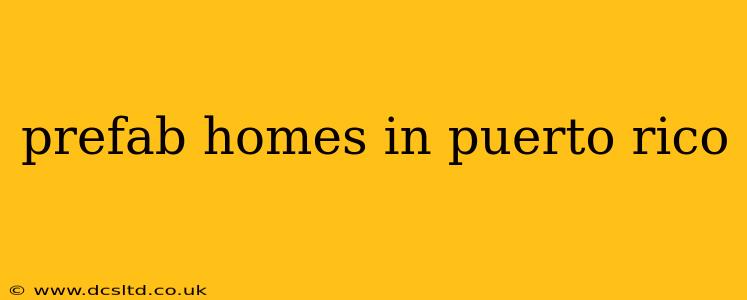Puerto Rico, an island known for its vibrant culture and stunning landscapes, faces significant challenges in providing affordable and resilient housing. Prefabricated homes, or prefab homes, are emerging as a compelling solution, offering a faster, more efficient, and potentially more sustainable approach to construction. This comprehensive guide explores the advantages and considerations of choosing a prefab home in Puerto Rico.
What are Prefab Homes?
Prefab homes are structures built off-site in a controlled factory environment and then transported to the final location for assembly. This differs significantly from traditional "stick-built" homes, which are constructed entirely on the building site. The factory setting allows for greater precision, quality control, and often, faster construction times.
Advantages of Prefab Homes in Puerto Rico
Several factors make prefab homes particularly attractive in the Puerto Rican context:
-
Faster Construction: Prefabrication significantly reduces construction time, a crucial advantage given the island's housing needs. This speed can translate to quicker occupancy and a faster return on investment.
-
Cost-Effectiveness: While initial costs might seem comparable, prefab homes can ultimately be more cost-effective due to reduced labor costs, less material waste, and faster completion. This is particularly beneficial for those seeking affordable housing options.
-
Resilience to Natural Disasters: Puerto Rico is susceptible to hurricanes and earthquakes. Modern prefab homes can be engineered to withstand these events better than traditional homes, incorporating advanced building materials and techniques for greater structural integrity.
-
Sustainability: Prefab construction often leads to less waste compared to traditional methods. Moreover, builders can incorporate eco-friendly materials and design features, resulting in more environmentally conscious homes.
What are the Different Types of Prefab Homes Available in Puerto Rico?
The prefab home market offers a variety of options:
-
Modular Homes: These homes are built in sections (modules) in a factory, then transported and assembled on-site. They offer flexibility in design and customization.
-
Manufactured Homes: Often confused with modular homes, manufactured homes are built to a national standard and are typically smaller and more affordable.
-
Panelized Homes: These homes use pre-fabricated wall panels, roof panels, and floor panels that are assembled on-site, offering a balance between customization and efficiency.
Are Prefab Homes More Expensive Than Traditional Homes in Puerto Rico?
The cost of a prefab home versus a traditionally built home can vary depending on several factors, including size, materials, design complexity, and location. While initial costs may be similar, the faster construction time and reduced labor costs can lead to overall cost savings in many cases.
What are the Permits and Regulations for Building Prefab Homes in Puerto Rico?
Building permits and regulations vary depending on the municipality. It’s essential to research local requirements thoroughly before commencing any construction project. Consulting with an experienced contractor familiar with prefab construction in Puerto Rico is highly recommended.
How Much Does it Cost to Build a Prefab Home in Puerto Rico?
The cost of building a prefab home in Puerto Rico can range significantly depending on size, features, and location. Obtaining multiple quotes from reputable prefab home builders in Puerto Rico is essential to get an accurate estimate.
What are the Pros and Cons of Prefab Homes?
Pros:
- Faster construction
- Potentially lower costs
- Increased resilience to natural disasters
- Potential for sustainability
Cons:
- Limited customization options (depending on the type of prefab home)
- Transportation costs
- Potential for site limitations
Conclusion
Prefab homes offer a promising solution to Puerto Rico's housing challenges. By combining speed, efficiency, resilience, and sustainability, they can contribute to creating more affordable and disaster-resistant communities. Thorough research, careful planning, and collaboration with experienced professionals are key to a successful prefab home project in Puerto Rico.
